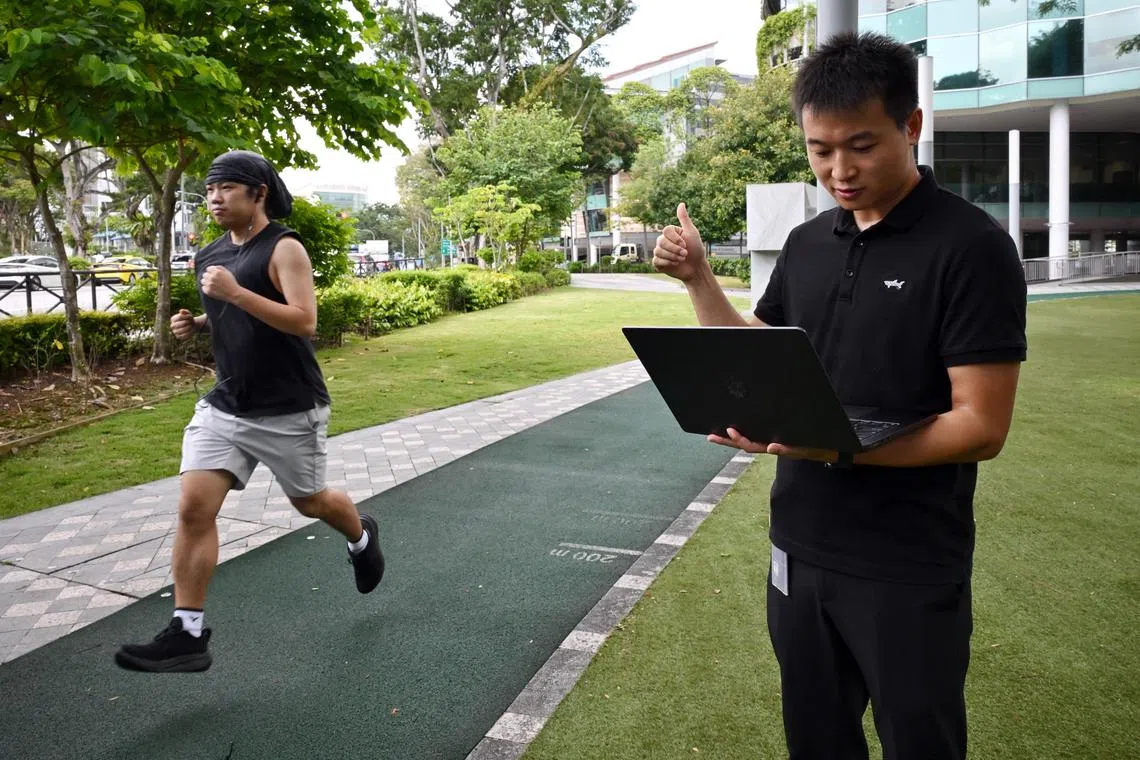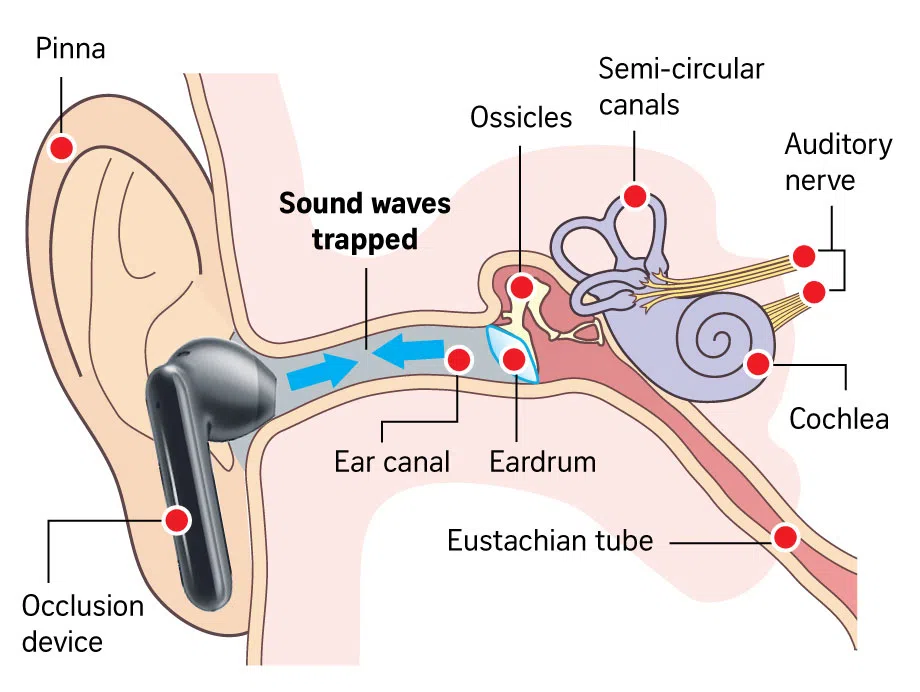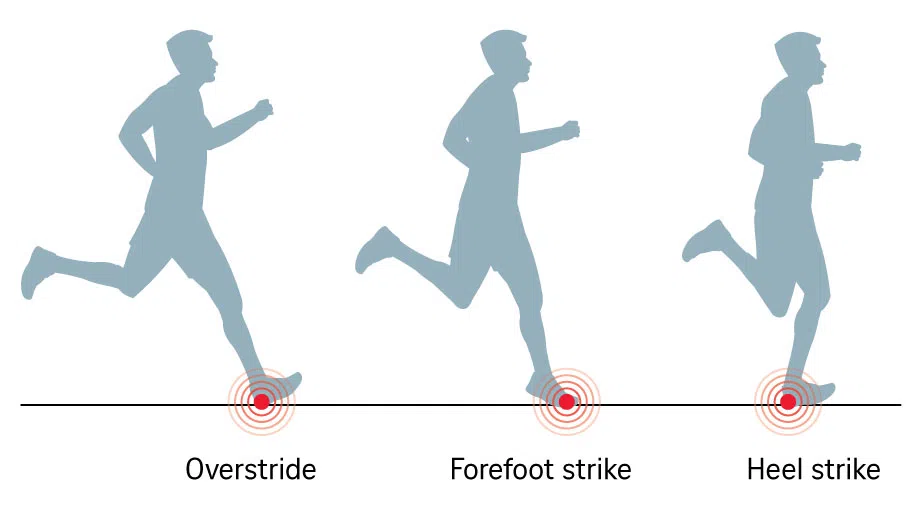SMU team develops prototype earbuds to monitor runners’ breath and foot strikes
Sign up now: Get ST's newsletters delivered to your inbox

The BreathPro earbuds have microphones that monitor whether a runner breathes in and out through his nose or mouth.
ST PHOTO: KUA CHEE SIONG
Follow topic:
SINGAPORE - As runners focus all their energies and attention on achieving certain personal targets, they may forget a couple of key things – how they are breathing and how their feet are striking the ground.
A team from Singapore Management University (SMU) has come up with a system to help runners monitor these two areas that could help them improve their performance.
BreathPro was developed by researchers from the university’s School of Computing and Information Systems, working together with collaborators from the University of Cambridge.
It primarily features a pair of earbuds for runners, similar to the earbuds many of them use to listen to music during their workouts.
The BreathPro earbuds have microphones that monitor whether a runner breathes in and out through his nose or mouth, as well as detect how his feet strike the ground – on the forefoot or the heel.
According to Assistant Professor Ma Dong, who led the research team, there have been studies measuring breathing rate or the number of breaths per minute, but none measuring how runners breathe. “With BreathPro, we are able to fill this gap,” he said.
Working with 25 study participants on the project, the research team identified four breathing modes: inhaling and exhaling through the nose, and inhaling and exhaling through the mouth.
These breathing modes are significant in performance sports.
Breathing through the nose is usually favoured during endurance activities like marathons because it filtrates air efficiently, and retains moisture and warmth, which enhances oxygen intake and reduces respiratory discomfort.
Breathing through the mouth is preferred during high-intensity bursts of activity, such as sprints and dashes.
The choice of breathing through the nose or the mouth, Dr Ma said, also depends on factors such as fitness level and respiratory health.
The customised earbuds comprise a 3D-printed shell and two analogue microphones – one placed near the earbud tip to capture in-ear sound and the other one integrated into the end of the earbud handle to pick up outside sounds.

According to Assistant Professor Ma Dong (left), who led the research team, there have been studies measuring breathing rate but none measuring how runners breathe.
ST PHOTO: KUA CHEE SIONG
Both microphones are connected to a development board through a 3.5mm audio jack for data recording. This board is then linked to a credit card-size computer to collect data from a runner.
The participant wears the earbuds and the rest of the prototype components are in a small bag carried during the run.
The team started building BreathPro in August 2023 and the project was completed in May 2024.
Next up is the application of BreathPro in different running scenarios, to see how runners can make interventions to improve their performance when given information about how they breathe when they run.
“BreathPro leverages the in-ear microphone on the earbuds to record breathing sounds. It also combines with the out-of-ear microphone on the same device to mitigate external noises. In doing so, we enhanced the clarity of in-ear breathing sounds,” said Dr Ma.
“Since both the in-ear and out-of-ear microphones struggle to capture a strong breathing signal with clear inhale and exhale transitions, we also attached another microphone on the philtrum under each participant’s nose,” he said.

BreathPro primarily features a pair of earbuds for runners, similar to the earbuds many of them use to listen to music during their workouts.
ST PHOTO: KUA CHEE SIONG
The team also applied technology to the in-ear audio stream to recognise the four breathing modes.
In data collected from 25 participants in the project, BreathPro achieved an accuracy of between 90.7 and 98.52 per cent in classifying the four breathing modes.
“This performance is sound even under a range of challenging conditions, such as varying intensities and types of ambient noise, as well as different inhalation and exhalation sequences,” Dr Ma said.
Identifying running gait and footstrike pattern
As the researchers focused on gathering data regarding breathing modes, they also discovered data from another source – a low-frequency sound.
“The earbuds block the opening of the ear canal, forming a closed space between the eardrum and earbuds. This acts like a cave, where all the sounds that the body receives and generates are trapped within this cave. Here, we concluded that (the low-frequency) sounds were coming from the bones when the feet strike the ground during running,” Dr Ma said.
This was when the team decided to also focus on the landing posture of the runners’ feet, which is a crucial parameter for both running safety and efficiency.
The researchers can identify three different gaits from the low-frequency sound.
First, there is the overstride, which happens when the front leg extends too far forward during running. This is often seen as improper and dangerous, potentially causing discomfort or injuries.
It might also decrease energy efficiency as it increases the braking force exerted on the body.
The second gait is a forefoot strike, where the runner lands on the ball of the foot or toes. This is typically effective for sprinting, but landing too far forward on the toes is not recommended for longer distances, as it may result in shin splints or other injuries.

BreathPro was developed by researchers from Singapore Management University’s School of Computing and Information Systems, working together with collaborators from the University of Cambridge.
ST PHOTO: KUA CHEE SIONG
The third is a heel strike. This is where a runner lands with the heel during a normal stride – a preferred strike pattern for distance runners, as it is more energy-efficient at medium speeds. However, heel strikes can put additional strain on the knees, potentially leading to knee and hip pain.
Dr Ma said: “We specifically wanted to detect these three types of running gaits. We leveraged the in-ear microphone in the earbuds to measure the low-frequency sounds or vibrations generated at the foot, passed on to the ear canal, and amplified by the occlusion effect.”
An occlusion effect occurs when the outer portion of the ear canal is plugged, causing a person to perceive echo-like booming sounds generated from his own voice.
“Since different parts of the foot have different compositions of tissues and bones, the vibrations generated by different gait types exhibit different patterns,” Dr Ma added. “Similar to what we did with the study into the different modes of breathing, we devised a signal processing and machine learning pipeline to classify the gait types. We collected data from the same 25 subjects using our prototype and found that our system achieved 87.8 per cent accuracy.”
One factor affecting the gait data is the type of running shoes worn, due to the varying sole materials and air cushioning thicknesses.
Dr Ma hopes that BreathPro can help Singapore athletes maximise their performance.
“In the future, we plan to apply the domain knowledge of running – such as the optimal gait type for different speeds, stages of the run and breathing patterns – to design a coaching system.
“For instance, runners can specify the distance and duration before the run, and the system can suggest the gait type and breathing mode. During the run, the system can provide audio guidance to the runners, correcting their improper gaits when detected,” he said.
Rationale for using ear-worn device

• An occlusion effect happens when an object fills the outer portion of a person’s ear canal, causing that person to perceive echo-like hollow or booming sounds generated from his own voice.
• The occlusion effect occurs in the grey area where the sound waves are trapped in the ear canal and these can be recorded by the in-ear microphone attached to the earbud.
Breathing types in running

• During running, people can breathe using their mouth (oral) or nose (nasal), or a combination of both. The best breathing mode depends on the intensity of the run, temperature and humidity.
• Oral breathing leads to higher oxygen consumption, ventilation and respiration rate, while nasal breathing facilitates the regulation of air flow and ensures a steady intake of oxygen.
• Oral breathing aids in dissipating heat efficiently by facilitating greater air flow and faster cooling, while nasal breathing helps to warm and humidify the inhaled air in the nasal cavity.
• BreathPro is a non-invasive, cost-effective and motion-resilient solution for monitoring vital signs during exercise. It is a novel piece of research that detects whether a runner is breathing through the mouth or nose. Should the runner show symptoms like over-breathing or shortness of breath, the BreathPro system can identify them in real time.
Landing poses in running

• Overstride refers to the front leg of the runner extending too far in front of his centre of mass. This may lead to injuries and decrease running energy efficiency.
• Forefoot strike refers to the runner landing on the ball of the foot or toes. It is effective for sprinting but is not recommended for longer distances as it may lead to shin splints.
• Heel strike refers to the runner landing with the heel. It is more energy-efficient at slow to medium speeds. However, it also exerts additional strain on the knees, leading to knee and hip pain.
• The selection of strike depends on the stage of the run, proficiency level of the runner and his preference.
• The researchers leverage the in-ear microphone on wireless earbuds to capture the vibrations generated by foot strikes. Landing with different parts of the foot generates distinct vibration patterns, and the BreathPro researchers use machine learning to classify these patterns for running gait detection.
• With data collected from 25 subjects, the BreathPro system achieves an accuracy rate of 87.80 per cent in identifying three gait types.


